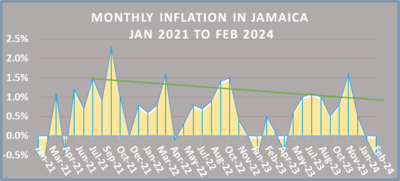 Point-to-point inflation in Jamaica has bent back close to the Bank of Jamaica’s target of 4-6 percent based on the February 2024 data released by the Statistical Institute of Jamaica, with a reading of 6.2 percent following monthly inflation plunging by 0.6 percent for the month and follows a fall of 0.10 percent in January.
Point-to-point inflation in Jamaica has bent back close to the Bank of Jamaica’s target of 4-6 percent based on the February 2024 data released by the Statistical Institute of Jamaica, with a reading of 6.2 percent following monthly inflation plunging by 0.6 percent for the month and follows a fall of 0.10 percent in January.
The decline was influenced by the decreases in the index for the divisions ‘Food and Non Alcoholic Beverages’ (1.1 percent) and ‘Housing, Water, Electricity, Gas and Other Fuels’ (1.6 percent).
Negative inflation in February
Interest rates held at 7% for Jamaica
Interest rates set by the Bank of Jamaica held at 7 percent for the overnight deposits, even as inflation continues to fall rapidly in the country and now running at an average of 0.20 percent per month or 2.4 percent annualised since November last year. The monetary Policy Committee determined the decision at meetings held this week.
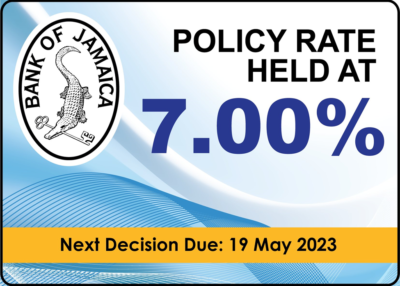 According to the country’s central bank, “Inflation continued to ease, consistent with Bank of Jamaica’s monetary policy and international developments. Jamaica’s inflation rate to February 2023 of 7.8 percent was below the rate of 8.1 percent at January 2023. The February outturn was the lowest rate since December 2021.”
According to the country’s central bank, “Inflation continued to ease, consistent with Bank of Jamaica’s monetary policy and international developments. Jamaica’s inflation rate to February 2023 of 7.8 percent was below the rate of 8.1 percent at January 2023. The February outturn was the lowest rate since December 2021.”
The key external drivers of headline inflation, such as grains, fuel and shipping prices, continued to decline, broadly in line with the Bank’s expectations. In addition, inflation expectations continued to track.
Core inflation (excluding food and fuel prices from the Consumer Price Index) at February 2023 also decelerated to 6.6 percent from 7.1 percent at January 2023 and is projected to fall further as monetary policy remains tight.
Annual inflation is projected to continue to fall to the Bank’s inflation target range of 4 to 6 percent by the December 2023 quarter. One-off regulated price adjustments may, however, result in a temporary uptick in inflation.
Notwithstanding positive developments in inflation, “the MPC noted that the risks to the inflation outlook remain elevated. In a context where the domestic economy continues to grow, labour market shortages carry the potential for future wage adjustments that can put upward pressure on inflation.
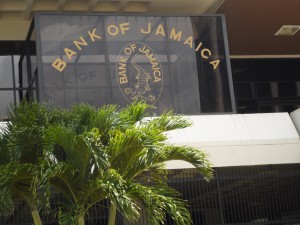
BOJ holds overnight rate.
Higher inflation could also result from a worsening in supply chain conditions and higher commodity prices if there are further geo-political disruptions. Among the factors that could lead to lower-than-projected inflation, weaker-than-expected global growth could negatively affect domestic demand, and some projected adjustments to regulated prices may not materialise.”
“Therefore, to continue underpinning inflation returning to the target range and to underwrite continued stability in the foreign exchange market, the MPC unanimously agreed to hold the policy interest rate at 7 percent, to maintain tight Jamaican dollar liquidity in the money market and to continue fostering relative stability in the foreign exchange market. The Bank’s liquidity management strategy incorporates the impact of the one percentage point increase in the domestic and the foreign currency Cash Reserve Requirements applicable to DTIs, effective the beginning of April 2023.”
Jamaica’s inflation is tamed
Inflation in Jamaica is tamed. At least that is what data out of the Statistical Institute of Jamaica (STATIN) is suggesting, with negative inflation for the first four months of the year.
According to the latest data on the Consumer Price Index (CPI), the inflation rate for April 2020 was 0.2 percent. The increase for April comes on the heels of low price increases from December last year, leading to a rise of 0.5 percent in the CPI index followed by January, with a negative price movement of 1.1 percent. 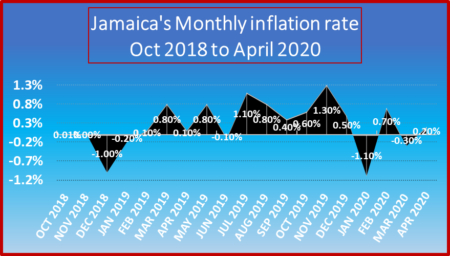 February ended, with an increase of 0.7 percent, while March had a decline of 0.3 percent and with the April fall, the year to date movement came out at negative 0.5 percent.
February ended, with an increase of 0.7 percent, while March had a decline of 0.3 percent and with the April fall, the year to date movement came out at negative 0.5 percent.
The inflation rate for April is not directly comparable to the previous periods, but whatever difference there maybe is unlikely to be material. Statin updated the basket of goods and services used in the compilation of the index. Accordingly, the products and services included in the new CPI basket and the weights associated with each item have changed based on a 2017 Household Expenditure Survey. The difference between the old and new weighting is not substantial, with Food and Non-Alcoholic Beverages weighting of 37.4 percent previously, is now down to 35.8 percent. The group of Housing, Water, Electricity, Gas & Other Fuels is up to 17.8 percent from 12.8 percent previously. Transport is now at 11.2 percent versus 12.8 percent in the old basket. Recreation, Sports & Culture is at 5 percent compared to 3.4 percent in the previous measure. The only other change of note was the areas of Insurance & Financial Services that is now 1.1 percent. Previously it was grouped with Personal Care, Social Protection & Miscellaneous Goods & Services that amounted to 8.4 percent of the overall basket, with the new weighting for the new category, down to 5 percent.
According to STATIN, the reduction in the GCT rate, from 16.5 percent to 15 percent, impacted the inflation rate for April 2020. The ‘Food and Non-Alcoholic Beverages’ recorded an increase in its index of 0.3 percent. The inflation rate for the division ‘Housing, Water and Electricity’ was 0.2 percent due to a rise of 3.1 percent in the index for the group ‘Water Supply and Miscellaneous Services Relating to the Dwelling.’ The Transport division declined by 0.5 percent and was mainly attributable to the reduction in the costs of petrol.
Big inflation spike in 2019
The Statistical Institute of Jamaica (STATIN) reported that the annual inflation rate in Jamaica to December 2019, was 6.2 percent, a sharp increase from inflation over the last four years.
 According to data from the Statin, inflation in 2018 was 2.4 percent, down from 5.2 percent in 2017. In 2016 the inflation rate ended at 1.7 percent and 3.7 percent in 2015, 6.4 in 2014 and 9.7 percent in 2013.
According to data from the Statin, inflation in 2018 was 2.4 percent, down from 5.2 percent in 2017. In 2016 the inflation rate ended at 1.7 percent and 3.7 percent in 2015, 6.4 in 2014 and 9.7 percent in 2013.
Jamaica’s Central Bank, in response to the sharp rise in the inflation for the year, stated, the outturn “represents a sharp jump when compared with the 3.4 percent recorded in September 2019. This inflation outturn was not anticipated and was higher than the Bank of Jamaica’s target of 4.0 to 6.0 percent.”
The release from Bank of Jamaica, stated, “the higher inflation rate was primarily influenced by faster increases in food and energy-related prices in the consumer price index (CPI). The heavily weighted Food & Non-Alcoholic Beverages division of the CPI increased over the year to December by 10.7 percent, when compared with 6.7 percent in September 2019. This was primarily related to higher prices for vegetables and starchy foods, the consequence of adverse weather conditions (drought followed by heavy rains) that affected the Island between June and October 2019.

BOJ interest cuts overnight rate.
There was also news of crop-related diseases affecting some items. Housing, Water, Electricity, Gas & Other Fuels reflected higher rates for electricity and water, which was partly related to increases in international oil prices in the December 2019 quarter. This division increased over the year to December to 1.5 percent, compared with a decline of 3.2 percent in September 2019.”
The release continues, “despite the higher headline inflation, underlying inflation, which excludes the immediate influence of agriculture and energy prices, remained stable and below 3.0 percent. At the end of December 2019, the annual rate for this measure was 2.9 percent, which was unchanged compared with the rate in September 2019. This underscores that the Jamaican economy continues to reflect some slack with economic growth below its potential. It also highlights that the jump in inflation is likely to be temporary as expected tempered movements in agricultural prices dampen inflation over the next three to six months.”
Jamaica’s inflation up 0.8% in March
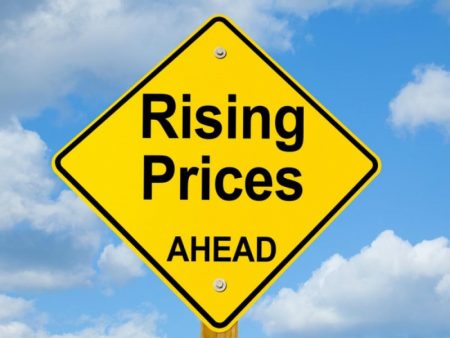 Inflation in Jamaica rose 0.8 percent in March and brings the year to 0.7 percent date data released by the Statistical Institute of Jamaica (STATIN) shows and the fiscal year inflation to 3.4 percent.
Inflation in Jamaica rose 0.8 percent in March and brings the year to 0.7 percent date data released by the Statistical Institute of Jamaica (STATIN) shows and the fiscal year inflation to 3.4 percent.
According to Statin, the movement was mainly attributable to a fall of 0.9 percent in the index for the heaviest weighted division Food and Non-Alcoholic Beverages and a 1.5 percent rise in the Housing, Water, Electricity, Gas and Other Fuels division at resulted from a 2.7 percent increase in the group ‘Electricity, Gas and Other Fuels’. Also contributing to March’s inflation rate was an increase of 1.1 percent in the index for the ‘Transport’ division. This was mainly attributable to the rise in petrol prices.
Food prices pressure November’s inflation

Food category was main contributor to November’s inflation.
According to STATIN, the “movement was mainly the result of a 1.2 percent rise in the index for the heaviest weighted division Food & Non-Alcoholic Beverages. Transportation moved up by 1 percent due to higher petrol prices and airfares, and Education increasing by 0.2 per cent, as a result of an increase in the cost of CSEC examination fees. The impact of the month’s inflation was however tempered by the 0.9 percent fall in the index for the division ‘Housing, Water, Electricity, Gas and Other Fuels, with lower cost for electricity being the main contributing factor.”
Year-to-date inflation is 4.6 percent, while inflation for the past 12 months is up 4.9 percent and the fiscal year-to-date movement was 3.6 per cent.
The relatively large revaluation of the Jamaican dollar against the US dollar since September, will have a moderating impact on inflation going forward.
 Statin also stated that inflation for October came in at points 0.8 percent, sharply down from the same period last year at 1.5 percent. October’s inflation is worse than the 0.5 percent that occurred in September this year. But spike in oil prices would have played a big role in October inflation. The fall in oil price to the low $70 levels currently, is signalling that inflation in November is likely going to be moderate with the year to date inflation then heading for the low 4 percent range.
Statin also stated that inflation for October came in at points 0.8 percent, sharply down from the same period last year at 1.5 percent. October’s inflation is worse than the 0.5 percent that occurred in September this year. But spike in oil prices would have played a big role in October inflation. The fall in oil price to the low $70 levels currently, is signalling that inflation in November is likely going to be moderate with the year to date inflation then heading for the low 4 percent range. Recent data from a large number of listed companies show sluggish revenues growth and lower profit for the September quarter compared with 2022 as well as the first half of 2023, added to this, tourist arrivals slowed considerably in recent months compared to the earlier part of the year and that industry has been the major driver of economic activity this year and added to that the construction sector has been in decline and could worsen.
Recent data from a large number of listed companies show sluggish revenues growth and lower profit for the September quarter compared with 2022 as well as the first half of 2023, added to this, tourist arrivals slowed considerably in recent months compared to the earlier part of the year and that industry has been the major driver of economic activity this year and added to that the construction sector has been in decline and could worsen.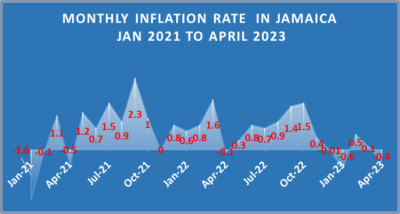 The dip in the point to point inflation below 6 percent was occasioned by a fall in the All-Jamaica Consumer Price Index (CPI) of 0.4 percent for April 2023 and was influenced mainly by a 4.2 percent fall in the index for the division ‘Housing, Water, Electricity, Gas and Other Fuels’. The movement in the division’s index was due to a reduction in the rates for electricity, which resulted in a 12.5 percent fall in the index for the group. There was also a decline in the index for the ‘Transport’ division, which moved down by 0.1 percent due mainly to reduced petrol and air travel costs. The inflation rate was, however, tempered by a 0.6 percent increase in the index for the heaviest weighted division ‘Food and Non-Alcoholic Beverages.
The dip in the point to point inflation below 6 percent was occasioned by a fall in the All-Jamaica Consumer Price Index (CPI) of 0.4 percent for April 2023 and was influenced mainly by a 4.2 percent fall in the index for the division ‘Housing, Water, Electricity, Gas and Other Fuels’. The movement in the division’s index was due to a reduction in the rates for electricity, which resulted in a 12.5 percent fall in the index for the group. There was also a decline in the index for the ‘Transport’ division, which moved down by 0.1 percent due mainly to reduced petrol and air travel costs. The inflation rate was, however, tempered by a 0.6 percent increase in the index for the heaviest weighted division ‘Food and Non-Alcoholic Beverages.





